 |
207 SQUADRON ROYAL AIR FORCE HISTORYKen Brown & the Stalag XIB (357) Memorial |
 REME |
based on an article in The Craftsman, Magazine
of the Corps of Royal Electrical
and Mechanical Engineers and the REME Association, July 2005 edition,
with permission.
this page has many images - please allow time for them to
load
Ken Brown of Ipswich (Navigator 11/43-1/44) was in P/O Dick Burnet's crew shot down on Berlin 30/31 Jan 1944 (EM-K EE173); all except Sgt Arthur Pulman survived and were POWs. Ken has worked for many years with others to have a memorial to those incarcerated in Stalag XIB at Fallingbostel. After overcoming setbacks the team saw this come to fruition for the 60th anniversary of the liberation of the camps in the Fallingbostel area, which held prisoners of many nationalities, Army as well as Air Force.
The Opening Of The STALAG XIB (357) MemorialCO 2 Bn: Lt Col GI Mitchell MBE The newly built STALAG XIB (357) POW Memorial Gates in Oerbke, near Fallingbostel, were officially dedicated on the 60th Anniversary of the camp's liberation on Saturday 16 April 2005. The dedication was the result of a seven year endeavour by Mr Ken Brown (a veteran RAF WO who was a prisoner in STALAG 357) and Mr Allan Purcell (Retd WO Army Catering Corps and also Mess Manager of 2 Bn Sgts' Mess). [the plaque reads: THE MEMORIAL PLAQUE Symbolised in the memorial are the gates, which were opened by the 8th Kings Royal Irish Hussars on 16 April 1945. Thus given freedom to the 17,000 prisoners of war held in captivity.] |
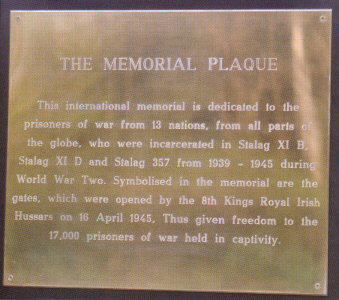 The memorial plaque |
The memorial is dedicated to the POWs of the 13 nations held at STALAG XIB and STALAG 357 and as such it was a multinational event. Representation was present from Russia, Poland, USA, France, Germany, Ukraine, Kazakhstan, Holland, Belgium, Canada, Belarus, Britain and Germany.
The main aim of the event was not only to dedicate the memorial to the POWs who were held at the camps, but in addition, provide a new beginning and a look forward for the German community of Fallingbostel and Oerbke.
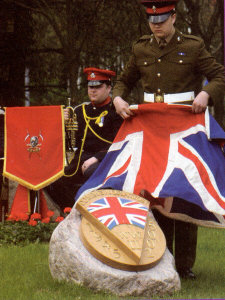 The unveiling of the stone |
In addition to the dedication of the gates, Mr
Les Allen (President of the National Ex Prisoner of War
Association) dedicated a memorial stone on behalf of all Ex
POWs.
The skilled tradesmen of 2 Bn constructed the memorial and you will be familiar with the design as it was centre stage of the front cover of the May issue of The Craftsman magazine. As you can see from the picture, the end result speaks volumes of the skills of our REME tradesmen. |
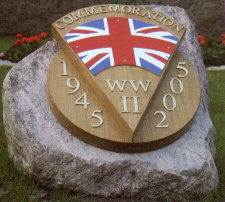 The commemorative stone fabricated by 2 Bn on behalf of the National Ex Prisoner of War Association |
Quite a few tears were shed this day with probably the most poignant point being the opening of the gates by children from the local British and German schools. Even the veterans of the day could not hold back the tears at this moment and they spoke of how touching they found the children's involvement.
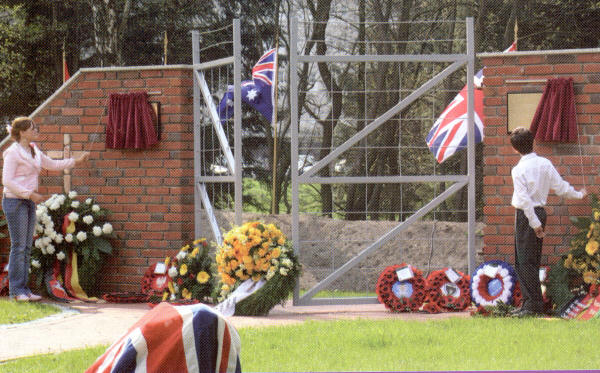
The children pull back the curtains to officially open the memorial
That evening they spoke of how this event may inevitably be their last, as age creeps up and the 70th anniversary seems so distant. Involving the young gave the veterans the confidence that they will not be forgotten.
| This memorial will ensure that 2
Bn, Fallingbostel and Hohne station, the communities of Oerbke
and Bad Fallingbostel will without a doubt, always remember
them.
The day was filled with beautiful . sunshine and, as ever, the visitors were made very welcome by the all ranks of the battalion and in particularly the Sgts' Mess (they may be in their eighties but they still know how to party and dance the night away ... ). The battalion has received numerous correspondences from the veterans, their children and special guests of the day, thanking us for the dedication and memories it has instilled. The CO, Herr Baumann (Commissioner of Oerbke) and I, thank all ranks of the battalion for their outstanding efforts in making this event the success that it was. |
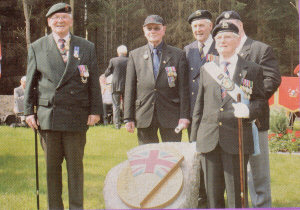 Ken Brown (in baseball cap) with other veterans at the commemorative stone: Mr Eric Reeves on the right with his new pace stick, courtesy of the RSM. |
The following is a short history of STALAG XIB (357) and the liberation by the 8th Hussars Recce Troop 60 years ago.
In 1934 with the introduction of conscription to the German Army, the Germans found themselves in need of land to train on. The wide open area of the Lunebeurger Heide seemed the ideal place. Work began on producing a training area capable of supporting two full divisions of troops at one time.
1935 saw the building of two barrack areas, Musterlager/ Bergen to the east and Fallingbostel/Oerbke to the west of the training area. Eleven of the villages in the area and many farms had to be evacuated (ruins of many of these can still be found today - evidence of fruit trees, stone walls etc can be seen all over the range area).
The training area opened in 1938 and by the summer of 1939,12 ranges were in use (one division requiring six weeks to complete its training programme). The workers used to build these huge complex barracks were housed in temporary wooden barracks built just outside Fallingbostel in the small village of Oerbke. In September 1939 the Polish armed forces received a pretty comprehensive lesson in armoured warfare - Blitzkreig from the Germans. Large numbers of prisoners taken by the advancing Germans started to become a problem. By October 1939 fences were built around the workers hutted camp and some of the Poles were sent there - STALAG XIB was born.
Although the camp was soon full, conditions at the start were good. The Polish soldiers were placed into Arbeitskommandos (working parties) and put to work in local factories, farms and as forestry workers on the land.
In May 1940, as the German Army moved west, Dutch, Belgium, French and British POWs were added to the camps in Germany - 40,000 arrived in STALAG XIB. Conditions began to deteriorate and hygiene was a major problem as the camps and village waterworks became overstretched. The outcome was an outbreak of Typhoid causing widespread and unrecorded deaths amongst the POWs. The situation was no better in 1941, Germany moved east - Russia was invaded on 22 June and shortly, after the first wave of Russian POWs began to arrive (12,000).
No room or accommodation was available; all that welcomed the Soviets was a large, flat open fenced area, 1,000 metre northeast of STALAG XIB in the area called Marquartsfeld. The Soviets being described by the Germans as sub-human were to be treated as such. They were put into the compound and left to fend for themselves. Most dug holes in the ground or made lean-tos from anything that could be found - this new camp was at first called STALAG 321, and then changed to STALAG XID.
STALAG XIC was built in another small village, 30km away on the other side of the training area at Bergen-Belsen!
Conditions in the new STALAG XID were so bad that in less then 12 months over 6,000 had died. Home Defence Battalions Landschutzen, normally old men not 100% fit for service, guarded the camps.
With the fall of Italy to the Germans in 1943 their one-time allies also arrived as POWs. The huge influx of Italians meant that once more the situation deteriorated. With the exception of the Soviet POWs the Italians suffered the most deaths in the camps. The Italian camp was situated on the area that is now Heide School - two hut foundations can still be seen in the field behind the RMP station.
By mid 1944 there were some 96,000 POWs in the camps and sub camps in the Fallingbostel/Oerbke area. The tide of war had changed and the Russian advance into Poland threatened to overrun the POW camps situated there. STALAG 357 was moved from Thorn in Poland to Oerbke, Italian POWs helped to construct a newer compound on the site of the old XID.
The beginning of October 1944 saw some 400 British Paratroopers, POWs captured at Arnhem, arrive at STALAG XIB. Included amongst them was the incomparable RSM, John Lord, ex Grenadier Guards attached to the Paras. RSM Lord took the conditions on as a personal challenge and starting with the men of the Parachute Regiment set out to change the state of the camp. He insisted that his men should wash and shave daily as if they were in barracks - also they should salute German Officers. He also demanded the men take some form of exercise daily.
In February 1945 both camps XIB and XID/357 were in a deplorable state - a lack of food and medical supplies plus the influx of American POWs captured after the Battle Of The Bulge, the German push into the Ardennes, was becoming a massive problem. In XID/357 conditions were made worse by the removal of mattresses and bed boards as a reprisal for alleged poor treatment of German POWs in Egypt by the Allies. In all of the camps POWs were still arriving in their thousands, even as the Allies advanced on all fronts.
Stalag 357 was a well-run camp - although some tension existed between the British Army POWs and the RAF POWs, as to the nature of activities within the camp. The RAF had an 'Escape and Intelligence Committee' that helped POWs attempt to escape. It also supplied information to the Allies on certain German activities.
The Army however, was much more concerned with causing as little trouble as possible so arguments did ensue. Eventually a vote was held to decide on an 'Overall Policy and a Head of Operations Spokesman'. The vote was carried overwhelmingly in favour of a RAF Warrant Officer; WO James 'Dixie' Deans who was to become 357s answer to RSM Lord.
In March 1945 the Allies crossed the Rhine and the British and American Armies advanced closer to the River Weser. In early April, the Germans decided to relocate 357; 'Dixie' Deans was called in front of the Commandant. The POWs were to move on foot to the northeast - destination unknown.
12,000 men from Camp 357 marched out north east with all they could carry in columns of 2,000 strong - WO Deans borrowed a bike and rode from column to column giving support, the weather was grim, typical for this time of the year, snow and rain. The men, hungry, tired, ill scavenged what they could find en route.
The patience of WO Deans snapped and he confronted the Comdt, Col Ostmann and demanded to be allowed leave to travel to the British Lines to get help. This may seem like an outrageous request but as Deans pointed out - the Germans were soon going to be overrun either by the Russians or the British. The colonel duly granted Deans a pass to carry him through enemy lines and assigned him a guard.
Tragedy struck the columns in the form of nine Typhoons of the RAF, who mistaking the POWs for the enemy, attacked the columns killing 60 and wounding more. Dixie Deans made it to the town of Lauenburg where he and his guard were found by advancing British Troops. The two of them returned to the columns and marched them back through to the British lines where his erstwhile captors surrendered.
On 16 April 1945 the 8th Hussars Recce Troop reached Fallingbostel. The autobahn marked on their maps was to their surprise no more than a sandy track. Two of the Honey Recce Tanks turned along the autobahn and followed it to a wide-open space from which they could see the first camp. Approaching the throng of newly freed people it became apparent that they were not British. This first camp was the Italians camp on Queens Ave - Adolf Hitler Strasse as it was then, the Heide School site.
The tanks moved on along the northern edge of the camp parallel to the road, crossing the railway tracks and sidings and reaching Fallingbosteler Strasse. Stopping some 50 metres from the autobahn bridge, they were unsure of the location of STALAG taque XIB as it was concealed by trees. However, one of the tank commanders noticed a figure amongst the trees with a maroon beret and from then on the job of locating the gate was easy. The tanks were met at the gates by a guard of `Very smart paratroopers' under RSM John Lord.
The situation at STALAG XID/357 was very different; none of the discipline evident earlier was seen, with dirty, ill fed and almost hysterically happy soldiers being the norm. STALAG XIB was the first British POW camp to be liberated by advancing troops. A few days later the newly freed Soviet POWs were causing chaos in and around Fallingbostel - they had looted most if not the entire town. The British put them back in the camps for safe keeping until repatriation to Russia was possible.
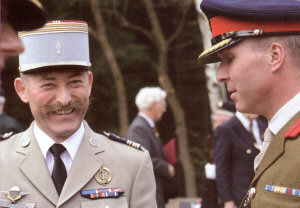 Col Henderson (late REME) DCOS 1(UK) Armd Div and Lt Col Fritz (French Army). Col Henderson helped design the memorial gates during his command of 2 Bn |
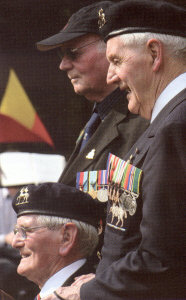 They were brothers in arms separated at Dunkirk when Mr Reeves (seated) was captured |
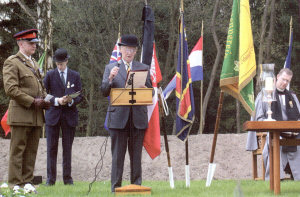 Maj Bill Bellamy (Retd) MC. As OIC Recce Tp, 8th HUSSARS, he recalled the day he and his troops liberated STALAG XIB and 357 |
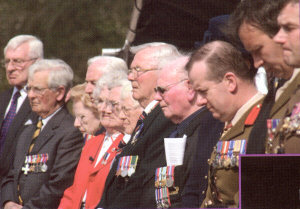 The GOC 1(UK) Armd Div, CO 2 Bn, 7 Armd Bde and veterans We will remember them |
Notes not part of the above article
adapted from a project page originally on the RAF Ex POW website
The Stalag XI B Memorial Project was the brainchild of Allan Purcell and stemmed from his keen interest in local history particularly in relation to the former Prisoner of War camps at Oerkbe. Allan is the civilian mess officer of the Second Battalion REME Warrant Officer's and Sergeant's Mess at the huge NATO Army establishment which is Fallingbostel Station.
Stalag XIB housed two of the most respected and well-known Prisoners. The immaculate RSM John Lord of Arnhem fame, and RAF WO Dixie Deans who did such sterling work when POWs were on the march and particularly when strafed at Gresse. Dixie Deans was the late president of the RAF Ex POW Association. It is hoped to include some form of tribute to them at the entrance to a proposed Visitor Centre, including Dixie's bike.
Apart from Stalag XIB also housed Larry Slattery and Georgie Booth, both of whom were shot down on September 4th 1939, in other words POW numbers 1 and 2. Larry is remembered by a musical scholarship funded by the RAF Ex-POW Association.
National Ex POW Association Newsletter Autmn 2004
(extract)
STALAG XIB/357 MEMORIAL PROJECT
Ken Brown, the UK Project Manager tells us: "At last, we have achieved something. The project has gone through a number of changes since the original concept, mainly due to lack of funds, but thanks to Colonel Henderson and No 2 REME Workshops, to say nothing of the efforts of Allan Purcell, a Memorial has been erected.
It takes the form of a brick structure with a centrepiece of open gates, thus symbolising the gates of freedom, opened by the Royal Irish Hussars on 16th April 1945. There remains cosmetic treatment of the site to be completed. The area is to be sown with grass, a rear fence is to be erected, a couple of benches to be installed and the descriptive brass plates in English and German to be fixed. The original proposal for an Information Centre has not been shelved. We have been given a 1939 Kreigie hut, which will be moved to site when funds permit and in this respect we are looking for a national sponsor."
from the editor of 207's website
Ken Brown, ex-207 Squadron and ex-POW, was the UK project manager and became involved with the proposal on a nostalgic return to Fallingbostel where he met Heinrich Bauman, the mayor of Oerkbe, and Allan Purcell. Heinrich Bauman is also a keen local historian and maintains a small museum at his office.
Ken, a Navigator, was on No.207 Squadron, 5 Group Bomber Command, from November 1943 until he was shot down in P/O Dick Burnet's crew. Their Lancaster mkIII EM-K EE173 took off from RAF Spilsby at 1720 for a raid on Berlin on 30 January 1944. Within moments of bombing and while clearing the target area at 19,500 ft, the aircraft was raked by cannon fire from a night fighter.
The port wing was set on fire and the order to abandon was given. Sgt Arthur Pulman, the Rear Gunner, who was killed in the engagement, has no known grave and is commemorated on Panel 236 of the Air Forces' Memorial at Runnymede. The rest of the crew were POWs. [source: RAF Bomber Command Losses of the Second World War, 1944 (WR Chorley, Midland Counties Publishing)] [in 2016 Sgt Pulman's grave was identified]
Ken died on 30th September 2012.
National Ex-Prisoner of War Association Newsletter, Summer 2005
FALLINGBOSTEL REPORT by Les Allan. "At the end of a very long march from Koenigsburg, East Poland I found myself incarcerated in Stalag XIB at Fallingbostel near Hannover. For this reason I have followed with interest the efforts of Allan Purcell to build a memorial befitting the memory of those who suffered and died within the confines of Stalag XIB.
Allan, who is the catering manager for the Warrant Officers and Sergeants Mess, phoned me earlier this year to tell me that everything was in place for an Inaugural Dedication Ceremony of the Memorial Gates, made by 2nd Bn Royal Electrical and Mechanical Engineers. The symbolic gates, situated on the site of the Stalag guardroom are dedicated to the memory of the prisoners of war who were liberated by the Royal Irish 8th Hussars sixty years ago, on 16th April 1945."
"I was accompanied by my wife Doris, our Standard Bearer Gary Moores and his wife and our Treasurer Freda Moores, as well as our Parade Marshal Eric Reeves and his wife May. Former Desert Rat Noel Mathews and his wife Dorothy made our party up to eight strong. We flew from Gatwick to Hannover on the morning of 15th April and were met at the airport by two very active and efficient REME drivers with minibuses for our luggage.
On our arrival at the Mess we were met by Allan Purcell who directed us to our living quarters. I learned afterwards that a number of sergeants had vacated their quarters in order to accommodate us. That evening our party sat down to an excellent lunch in the Mess, the fare being a little different to what I had experienced the last time I was in the area, the main meal at that time being whispering grass, and of course the appearance and state of the then company had also left a lot to be desired."
"After lunch we adjourned to the bar where many sergeants and their wives were quick to make us feel at home. I was surprised at the many questions put to me concerning the prison camp. Early in the evening we were introduced to RSM Mark Carlyle who, along with Mrs Wendy Carlyle made sure that we were all well looked after.
Like all RSMs Mark carried his badge of office under his arm, I refer of course to his pace stick. The pace stick immediately attracted the attention of our Parade Marshal Eric Reeves, who explained that it had been his ambition to obtain one from an ex-service equipment outlet in the UK, but they had proven to be too expensive. As the evening came to a close the Battalion CO Lt Col Mitchell and his Lady joined us to make sure that all efforts were in hand to make our stay a pleasant one."
"The dawn of Saturday 16th April was, weather wise, perfectly tuned to the Inaugural Dedication Ceremony of the Memorial Gates for the POWs who were liberated in Oerbke XIB. After a reasonably early breakfast the party was guided to where the memorial was located to witness a rehearsal of the afternoon proceedings, and I have to confess that the first sight of the memorial awoke memories of which I was both saddened to the point of tears and yet very, very proud of the infinitesimal part I had played in the fight for freedom. All that morning the REME lads were busily erecting marquees, not against rain but more against the sun. By mid-morning German TV crews and press camera men began to arrive and we found ourselves being bombarded with questions ranging from the day of liberation to our thoughts of the present times."
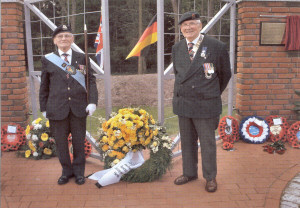 Eric with his new pace stick together with Les Allan |
"As the scheduled time of the Dedication Ceremony drew near
a Warrant Officer called the assembly to order by saying
before the dedication begins we have another duty to perform,
will Eric Reeves come forward.
Eric went forward and to his delight was presented with what he had wanted for many years - a pace stick." |
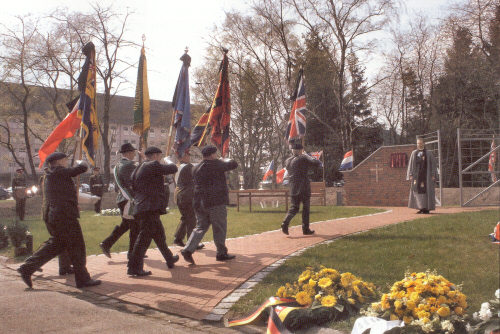
Parade of the Standards of veterans' organisations represented at the
ceremony
"The ceremony opened with a speech from General Cooper, OC UK Armoured Brigade, followed by speeches from Herr Heinrich Baumann, District Commissioner of Oerbke, Mr Ken Brown who was responsible for collecting funds in the UK with which to build the memorial and finally myself. The curtains covering the bronze plaque on the right wall were opened by a young lady, after which wreaths were laid. After the ceremony was concluded the VIPs and guests due to the very pleasant weather were very slow in dispersing, thus giving more time to answer the many questions from TV crews and also to examine the museum exhibits collected by Kevin Greenlagh, Germany Guard Service. Kevin is an associate member of our association.
After the ceremony we went back to the Sergeants Mess where we were ushered into a moderate sized room to find an excellent buffet had been set up. After the buffet preparations were put in hand to finish off the evening with a dance and by the time the evening closed I would venture to suggest that the Ladies in conjunction with the sergeants wives had danced the poor sergeants off their feet."
"In between the dances one of our wall plaques was presented to the Sergeants Mess by Our Standard Bearer Gary and a picture of the Last Ordeal by myself. It is worthy to note that less than half an hour after Gary presented the plaque I was taken into the Sergeants Mess, where in that very short time the plaque already enjoyed pride of place over the bar. The evening came to an end and very reluctantly we bade farewell and retired to the sleeping quarters.
The next morning after an excellent breakfast our party was escorted back to Hannover airport. Before we boarded the minibus Allan asked me if we would be going back next year. My answer was "we certainly will". Allan then said to make me feel more at home he would arrange for a bed of straw. My reply? "All here now is so clinically clean in comparison to 1945 that I fear you will have difficulty finding the bugs and lice to keep me really warm." With sincere hand shakes and thanks for all his hard and dedicated work involved in the building of this superb memorial, we bade farewell."
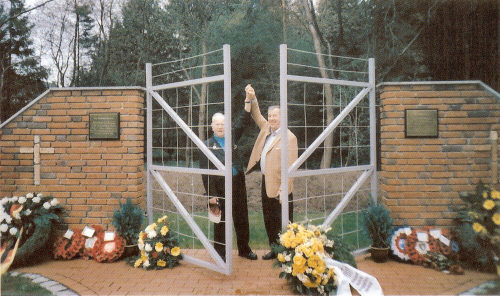
Ken Brown and Allan Purcell, the two project officers
PS Ken and Allan have acquired a building which will be used as a Visitors' Centre, but still need funding to move it to the site. So if you have any spare money or have won the lottery please contact Ken Brown at 25 Beechcroft Road, Ipswich IP1 6BA. They have applied to the lottery fund but they will not give money to overseas projects. (Or Veterans organisations such as ours - Editor of The National Ex-Prisoner of War Association Newsletter).
July 2005Ken was interviewed by during the 60th Anniversary of the ending of WW2 celebrations in London on National Commemoration Day 10th July 2005 (as reported in RAFA News 22 July 2005): "82-year old former Warrant Officer Ken Brown ... was a navigator on 207 Squadron and flew 10 ops over Germany, seven times to Berlin. However, his aircraft was shot down and he was taken prisoner. He was incarcerated in Stalag Luft XIb among other camps; in recent years Ken has been one of the driving forces behind attempts to build a prisoner of war memorial at Fallingbostel. His efforts culminated in a ceremony earlier this year which saw the PoW memorial gates formally inaugurated on the 60th anniversary of the liberation of the camp." |
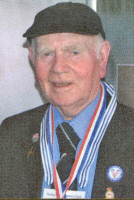 |
Do you have images or recollections of Stalag XIB?
please contact
the 207 History website editor
29 April 2005: Jacek Szymak, Ewingville, New Jersey: I am a son of a Stalag XIB survivor. My father, Tadeusz Szymak, was prisoner in Fallingbostel from 1941 until liberation. My family was taken from Poland in 41 for forced labour. My father has pictures of the camp taken after liberation.
29 Oct 2007: I was the craftsman from 2Bn who built the gates. I'm very proud of them and visit them everytime I'm back in Germany. It was an honour to make this memorial for the people of Stalag XIB. Kind regards CFN T Freeman.
Links
Fallingbostel
Military Museum STALAG XIB/357
National
Ex Prisoner of War Association Memorial at the National Arboretum
The
Corps of Royal Electrical and Mechanical Engineers and the REME
Association (Facebook)
207 Squadron RAF
History - RAF Escaping Society 1945-95 - RAF Ex POW Association
Wartime
Memories site Stalag XIB
Oliver Clutton-Brock Footprints
on the Sands of Time - RAF POWs in German hands
Bad Fallingbostel
last updated 20 Oct 2007: 23 Dec 13: 9 Jan 19: 19 Jan 20